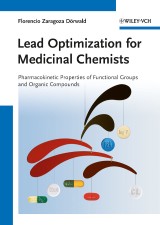Details

Lead Optimization for Medicinal Chemists
Pharmacokinetic Properties of Functional Groups and Organic Compounds1. Aufl.
|
156,99 € |
|
| Verlag: | Wiley-VCH |
| Format: | EPUB |
| Veröffentl.: | 04.02.2013 |
| ISBN/EAN: | 9783527645657 |
| Sprache: | englisch |
| Anzahl Seiten: | 622 |
DRM-geschütztes eBook, Sie benötigen z.B. Adobe Digital Editions und eine Adobe ID zum Lesen.
Beschreibungen
Small structural modifications can significantly affect the pharmacokinetic properties of drug candidates. This book, written by a medicinal chemist for medicinal chemists, is a comprehensive guide to the pharmacokinetic impact of functional groups, the pharmacokinetic optimization of drug leads, and an exhaustive collection of pharmacokinetic data, arranged according to the structure of the drug, not its target or indication. The historical origins of most drug classes and general aspects of modern drug discovery and development are also discussed. The index contains all the drug names and synonyms to facilitate the location of any drug or functional group in the book.<br />This compact working guide provides a wealth of information on the ways small structural modifications affect the pharmacokinetic properties of organic compounds, and offers plentiful, fact-based inspiration for the development of new drugs. This book is mainly aimed at medicinal chemists, but may also be of interest to graduate students in chemical or pharmaceutical sciences, preparing themselves for a job in the pharmaceutical industry, and to healthcare professionals in need of pharmacokinetic data.
PART I: Introduction<br> <br> THE DRUG DISCOVERY PROCESS<br> Pharmacokinetics -<br> Structure Relationship<br> The Future of Small-Molecule Drugs<br> <br> LEAD OPTIMIZATION<br> What Limits/Reduces Oral Bioavailability?<br> What Limits/Reduces Plasma Half-Life?<br> How to Improve bbb-Penetration?<br> How to Avoid CYP Inhibition/Induction?<br> How to Avoid Interaction with the HumanEther-'a-go-go-Related Gene (hERG)?<br> How to Prevent Toxicity?<br> Examples of PK-Optimization in Animals<br> <br> PART II: The Pharmacokinetic Properties of Compound Classes<br> <br> ALKANES<br> Metabolism<br> <br> ALKENES AND ALKYNES<br> Metabolism<br> <br> ARENES<br> Metabolism<br> <br> HALIDES<br> Fluorine<br> Chlorine<br> Bromine<br> Iodine<br> Alkylating Agents<br> <br> AZIDES<br> <br> NITRO COMPOUNDS<br> Metabolism<br> <br> AZO COMPOUNDS<br> <br> TRIAZENES<br> <br> NITRATES AND NITRITES<br> <br> N-NITROSO COMPOUNDS<br> <br> N-OXIDES<br> <br> ALCOHOLS<br> Metabolism<br> <br> PHENOLS<br> <br> ETHERS<br> Metabolism<br> <br> EPOXIDES<br> <br> PEROXIDES<br> <br> THIOLS<br> <br> THIOETHERS<br> Metabolism<br> <br> SULFOXIDES<br> <br> SULFONES<br> <br> ALIPHATIC AMINES<br> Basicity<br> Metabolism<br> Rates of N-Dealkylation<br> <br> QUATERNARY AMMONIUM SALTS<br> <br> AMIDINES<br> <br> GUANIDINES, ACYLGUANIDINES, AND BIGUANIDES<br> <br> Acylguanidines<br> Biguanides<br> <br> ANILINES<br> Metabolism<br> <br> HYDRAZINES, ACYLHYDRAZINES, AND HYDRAZONES<br> <br> ALDEHYDES<br> <br> KETONES<br> <br> CARBOXYLIC ACIDS<br> Metabolism<br> Bioisosteres of Carboxylic Acids<br> Amino Carboxylic Acids, N-Acyl Amino Acids, and Related Compounds<br> <br> <br> CARBOXYLIC ESTERS<br> <br> AMIDES<br> <br> LACTAMS AND IMIDES<br> Pyrazolone Antipyretics<br> Five-Membered Lactams as Nootropics<br> <br> NITRILES<br> <br> CARBONATES<br> <br> CARBAMATES<br> Carbamates as Hypnotics<br> <br> UREAS<br> <br> THIOCARBONYL COMPOUNDS<br> SULFONIC ACIDS<br> <br> SULFONIC ESTERS<br> <br> SULFATES AND SULFAMIC ACIDS<br> <br> PHOSPHONIC ACIDS<br> <br> PHOSPHORIC ACID DERIVATIVES<br> <br> N-(AMINOALKYL)BENZAMIDES, -BENZOATES, AND RELATED COMPOUNDS<br> <br> ARYLALKYLAMINES<br> Antihistaminics: History<br> <br> PHENETHYLAMINES (2-PHENYLETHYLAMINES)<br> Biological Activity of Phenethylamines<br> Metabolism<br> Tetrahydroisochinolines and Related Compounds<br> <br> AMINOALKYLINDOLES AND INDOLE ALKALOIDS<br> <br> PHENOTHIAZINES<br> Metabolism<br> <br> DIBENZAZEPINES AND RELATED TRICYCLIC COMPOUNDS<br> <br> 3-ARYLOXY-2-HYDROXYPROPYLAMINES (B-ADRENERGIC ANTAGONISTS; 'B-BLOCKERS')<br> Metabolism<br> <br> OPIATES<br> <br> N-(CARBOXYALKYL)-a-AMINO ACID AMIDES (PRILS)<br> <br> ANILIDES AND AMIDES OF GLYCINE<br> <br> PEPTIDES, PEPTIDOMIMETICS, AND RELATED OLIGOAMIDES<br> Peptidomimetics<br> Thrombin Inhibitors and Related Compounds<br> <br> OLIGOARYLAMINES, OLIGOARYLAMIDES, OLIGOARYLCARBAMATES, AND OLIGOARYLUREAS<br> <br> IMIDAZOLES<br> <br> TRIAZOLES<br> <br> PYRIDINES, PYRIMIDINES, AND RELATED COMPOUNDS<br> Proton Pump Inhibitors<br> <br> QUINOLINES<br> Tecans<br> Quinazolines<br> <br> NUCLEOSIDE ANALOGS<br> <br> DIHYDROPYRIDINES<br> <br> ARENESULFONAMIDES<br> Antibacterials<br> Diuretics<br> <br> SULFONYLUREAS<br> <br> BENZODIAZEPINES<br> <br> STEROIDS<br> <br> ANTHRACYCLINES<br> <br> ARYLACETIC, BENZOIC, AND RELATED CARBOXYLIC ACIDS (NSAIDS)<br> Salicylates<br> <br> QUINOLONECARBOXYLIC ACIDS (GYRASE INHIBITORS)<br> <br> B-LACTAMS<br> Cephalosporins<br> <br> PROSTAGLANDIN ANALOGS<br> <br> SARTANS<br> <br> STATINS<br> <br> FOLIC ACID ANALOGS (ANTIFOLATES)<br> <br> TAXANES<br> <br> MACROCYCLIC COMPOUNDS
Florencio Zaragoza Dorwald studied chemistry at the Georg-August University in Gottingen, Germany, and Universite LouisPasteur, Strasbourg, France, where he obtained his Ph.D. in 1990 on the synthesis of natural products under the guidance of M. Franck-Neumann and M. Miesch. He spent one postdoctoral year in both the groups of A. Pfaltz (University of Basel) and A. P. Marchand (University of North Texas), and then worked on the synthesis of unnatural amino acids at the Technical University of Dresden. From 1994 to 2007 he had a position as a medicinal chemist at Novo Nordisk A/S, Denmark. Currently, he is employed as organic chemist at Lonza AG in Visp, Switzerland.
Small structural modifications can significantly affect the pharmacokinetic properties of drug candidates. This book, written by a medicinal chemist for medicinal chemists, is a comprehensive guide to the pharmacokinetic impact of functional groups, the pharmacokinetic optimization of drug leads, and an exhaustive collection of pharmacokinetic data, arranged according to the structure of the drug, not its target or indication. The historical origins of most drug classes and general aspects of modern drug discovery and development are also discussed.<br> The index contains all the drug names and synonyms to facilitate the location of any drug or functional group in the book.<br> This compact working guide provides a wealth of information on the ways small structural modifications affect the pharmacokinetic properties of organic compounds, and offers plentiful, fact-based inspiration for the development of new drugs. This book is mainly aimed at medicinal chemists, but may also be of interest to graduate students in chemical or pharmaceutical sciences, preparing themselves for a job in the pharmaceutical industry, and to healthcare professionals in need of pharmacokinetic data.


















